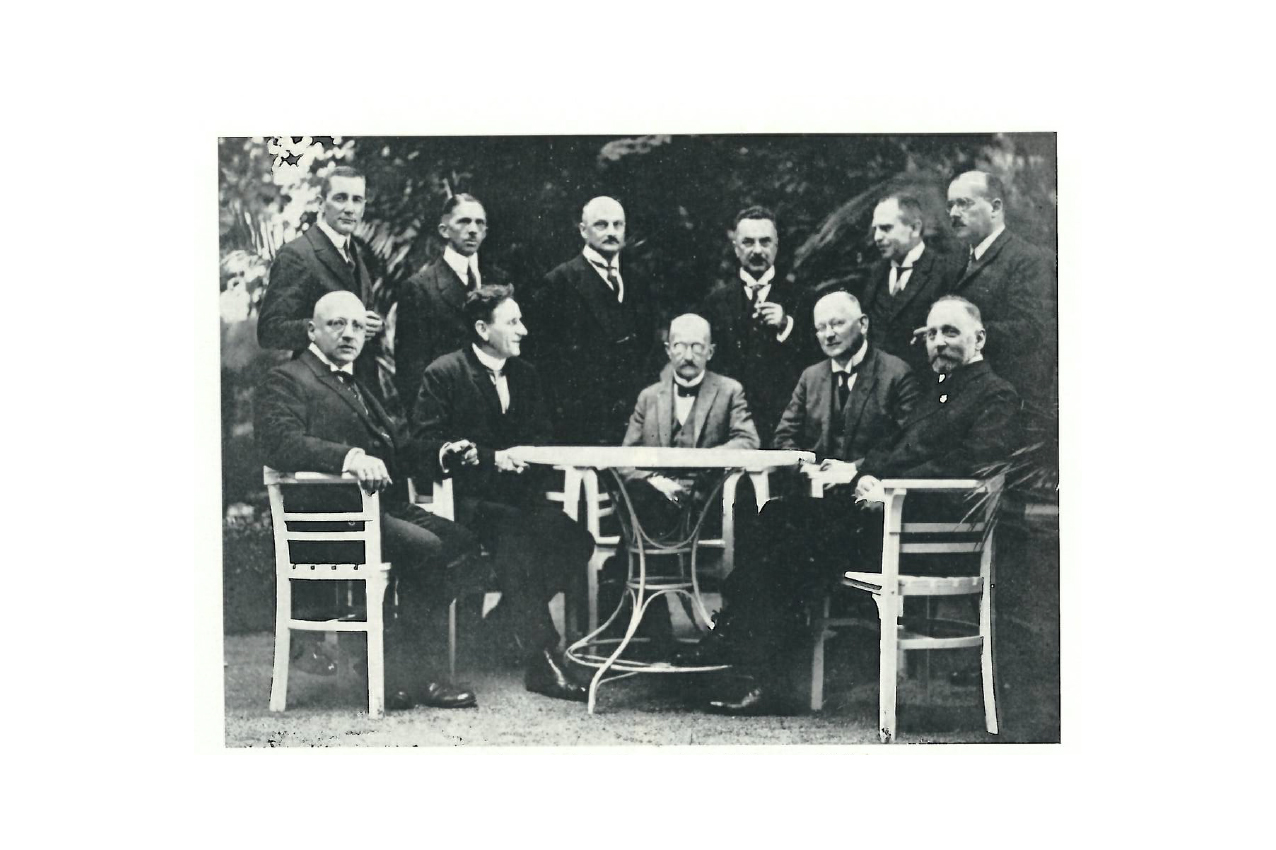The early years
Meetings in the Imperial children’s play room of the Berliner Schloss

The Berliner Schloss in the 1920s. The premises of the Notgemeinschaft were located on the 2nd floor to the right of the Eosanderportal.
© berliner-schloss.de
The Notgemeinschaft leased premises for their office in the Berliner Schloss (palace). The Schloss, which since 1914 had been occupied only by watchmen and other staff, was not used at all by the government from 1918.
Along with the Schlossmuseum, the new tenants that moved in were associations and institutions – e.g. the Kaiser Wilhelm Society and, from 1925, the newly founded DAAD (German Academic Exchange Service).

Friedrich Schmidt-Ott’s office in the Berliner Schloss
© Schmidt-Ott, Friedrich: Notgemeinschaft der Deutschen Wissenschaft, in: Das Akademische Deutschland Band III Die deutschen Hochschulen in ihren Beziehungen zur Gegenwartskultur, 1930, S. 607
F. Schmidt-Ott describes the operations of the Notgemeinschaft in the Schloss in his biography “Erlebtes und Erstrebtes” (Experiences and Aspirations):
“After temporary use of the Roosevelt Room in the Staatsbibliothek (State Library) which was available to me, I managed to obtain a series of rooms on the second floor of the Schloss, south of the Eosanderportal. My office was located there, near the entrance and next to those of my colleagues Schwoerer and Siegismund, with whom I was constantly engaging in exchanges on the issues that animated us. Adjacent to them the remaining rooms. The winding flight of stairs, numbering over eighty steps, did not precisely afford a comfortable ascent. On the way down I was in the habit of despatching them at a quick trot. The only lift in the place, which had been built in former times for the Kaiserin who had a heart complaint, was only made available for our use after quite some time. This situation did not present an obstacle to the lively stream of visitors to the Notgemeinschaft. The large children's play room of the Imperial princes even provided the opportunity to hold a Parliamentary Evening at least occasionally, but meetings of the Joint Committee and meetings of our committees and commissions in it at any time.”
The work of the Notgemeinschaft in the early years

Notgemeinschaft committee 1924 with Fritz Haber (front left) and Max Planck (centre)
© aus Zierold, Forschungsförderung in drei Epochen, 1968
At the inaugural session on 30 October 1920, the statutes were adopted and the Executive Committee, consisting of President Friedrich Schmitt-Ott and his two deputies Walther von Dyck and Fritz Haber, was elected.[A1]
The Notgemeinschaft's ways of working were very much geared to the President and the Executive Committee. Every proposal was submitted to the office; from there it was sent to the responsible expert committee for review, and after that review it was submitted to the Joint Committee. The Joint Committee presented an opinion; the final decision was a matter for the Executive Committee, with the President as its head.
The administrative staff of the Notgemeinschaft was very small, initially consisting of the President, two consultants, an assistant clerk and a clerk, together with two secretaries. Upon its founding, the Notgemeinschaft immediately had nearly 2,000 proposals to process. However, it was only possible to pay out grant funds from the summer of 1921, when Reich funds were finally released.
The Notgemeinschaft initially placed its funding focus on the improvement of scientific and academic infrastructure. It viewed its most important task as helping universities, first and foremost, to acquire international literature and journals. The purchase of laboratory supplies and test animals was also supported. According to the Second Report of the Notgemeinschaft, 58 proposals for research fellowships were approved from April 1922 to March 1923. The humanities were particularly strongly represented, with a share of 57 percent of the funding, since funding was primarily given to those scholarly endeavours that promised cultural prestige. It was not until the mid-1920s that the proportion shifted in favour of the natural sciences and technology.
The activities of the Library Committee

Second Report of the Notgemeinschaft, 1923
© Zweiter Bericht der Notgemeinschaft, 1923
For the Notgemeinschaft, the top funding priority was the restocking of gaps in the library inventory, in particular international journals. In German libraries overall, the number of international journals had fallen from 3,000 before the war to 250. However, purchasing international journals was hardly possible due to the weakness of the mark overseas and increasing inflation, meaning that the Notgemeinschaft had to find other ways to help the libraries.
Private individuals, libraries in other countries and other institutions donated money and material resources to the Notgemeinschaft, charging it with passing the funds on to scientific and scholarly institutions in need. For example, American benevolent organisation the Rockefeller Foundation donated money for the purchase of American and British medical literature, as can be gathered from the Third Report of the Notgemeinschaft 1923/1924.
Beyond the acquisition of literature through donations, the Notgemeinschaft developed a journal exchange between researchers and friendly foreign colleagues. The Notgemeinschaft created a list of the periodicals at its disposal, and those holdings could then be used for the purposes of exchange. The exchange campaign was a great success – in the 1922/1923 financial year the Library Committee reported around 300 exchange contacts, through which it was possible to obtain around 600 international journals.
At the suggestion of the Rockefeller Foundation, the Notgemeinschaft established subscription groups for approximately five university towns for each of the international journals donated by the Foundation. The journal folders were on display at a university for two months and were then passed on to the next university.
Further information
Access to the historical records
“GEPRIS Historisch” is the comprehensive information portal provided by the DFG that makes the history of the DFG and of research between 1920 and 1945 publicly accessible:
Information on literature used and sources